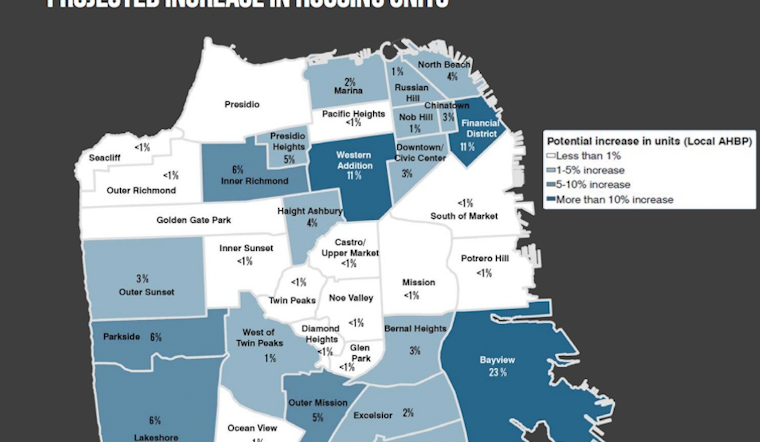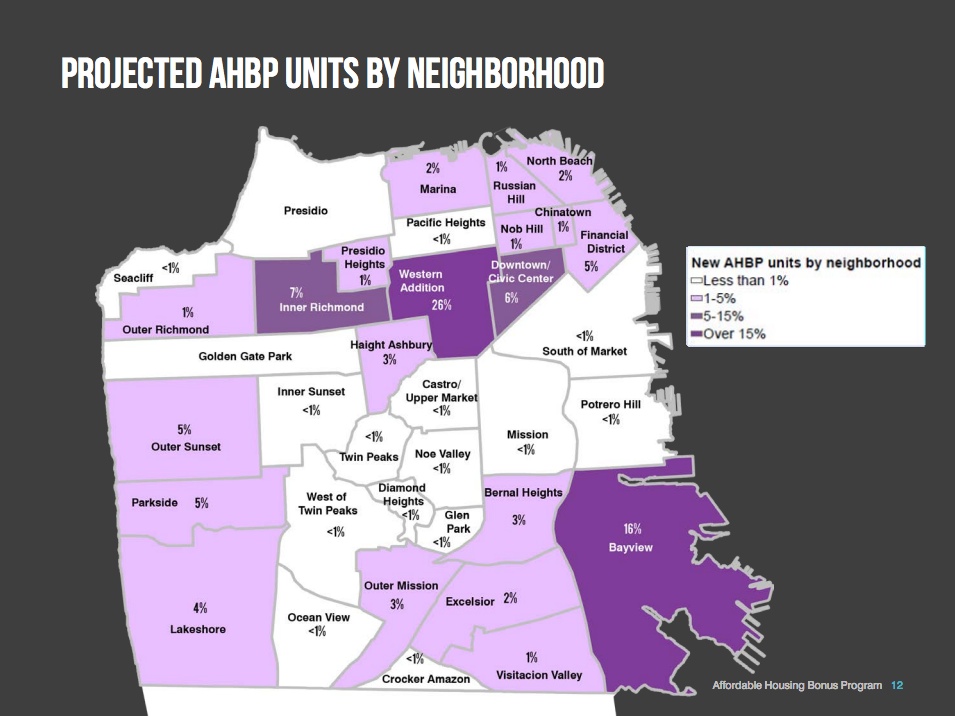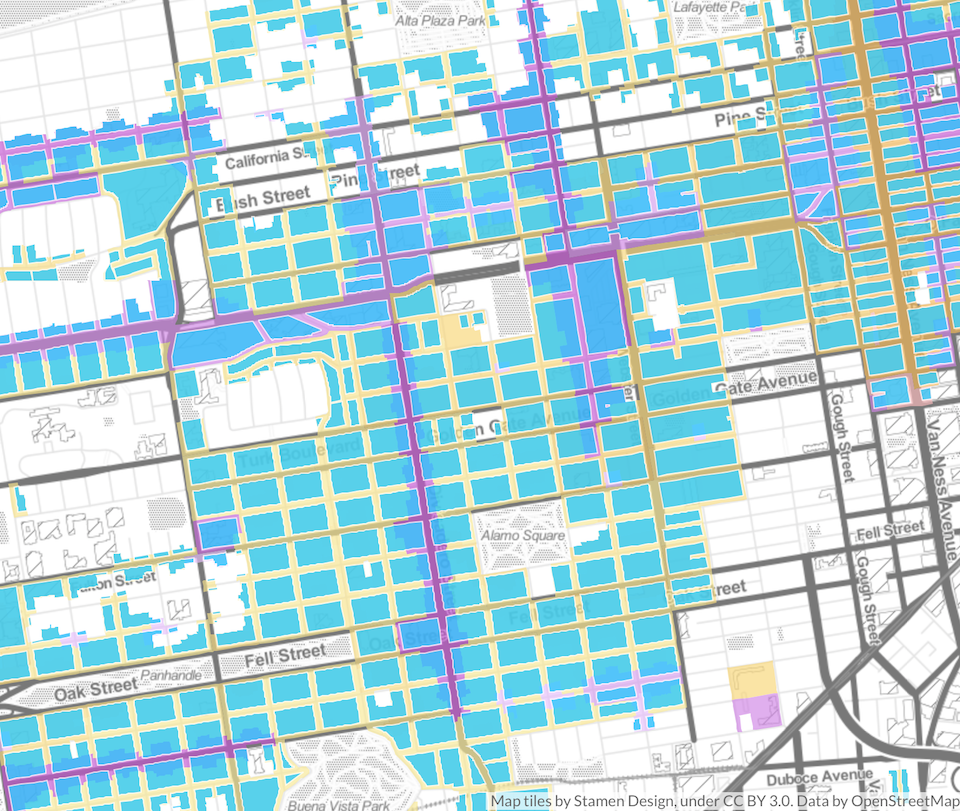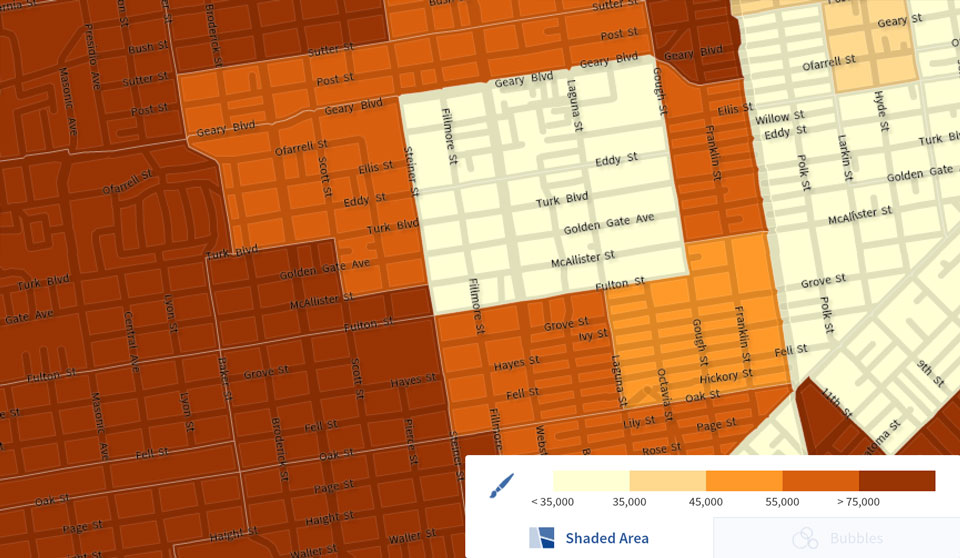
Developers might soon be able to build more floors on new buildings near transit centers across the city—provided they include more affordable housing units. That's what would happen if a city rezoning plan known as the Affordable Housing Bonus Program gets approved in the coming months.
While neighborhood groups across the city have vocally criticized the ABHP for a range of reasons, the Western Addition is likely to see much of the actual development created by the AHBP—up to 3,200 units, according to the Planning Department.
What's more, the affordable units in the new buildings are likely to still be priced out of reach for many residents in this part of the city.
Here's what's going on.
A Focus on "Soft Sites"
Last week, the Planning Commission voted to push its decision on the Affordable Housing Bonus Program (AHBP) to February 25th.
The idea behind the program is that subsidizing below-market housing is expensive, and letting developers build more lucrative market-rate units helps solve the problem, by making them the money they need to finance a higher number of below-market units.

Image: SF Planning
At numerous meetings in other districts, locals have voiced concerns about sunlight and views getting blocked, the nature of neighborhood character changing, the displacement of rent-controlled apartments, and rents going up for small businesses, among others.
But in light of both neighborhoods' recent zoning changes, Divisadero and the Fillmore will be particularly impacted. The Divisadero and Fillmore Neighborhood Commercial Transit Districts (NCTs) are specifically called out multiple times in the proposed AHBP legislation. It only applies to zoning districts with density restrictions—unless they are in the Divisadero or Fillmore NCTs. There are 38 NCTs in the city, so the exception is notable.
The Planning Department projects that the AHBP would impact the Western Addition more than any other area. An estimated 26 percent of AHBP housing would end up in the neighborhood, creating an 11 percent increase in the number of units. The maps above are based on soft sites available, not all possible AHBP-eligible parcels.
If passed, the AHBP could increase the height of several upcoming developments in both neighborhoods, including the ones slated for the current Touchless Car Wash and the former Harding Theater and Alouis Radiator spaces. The architects for those projects have not yet said whether they would take advantage of the AHBP if it passes.
Here’s a map of all parcels that could be eligible for height and density bonuses. It encompasses most land in both neighborhoods.

Eligible parcels are highlighted in teal. You can search for your specific address on the Affordable Housing Bonus Program Web Map.
Developer Incentives On Divisadero And Fillmore
The height bonus is fairly straightforward. Developers can add 20 feet, or two stories, if they build enough below-market-rate housing (even more if the entire building is below market rate). In addition, they can add five feet to the first floor if it is being used for commercial space, which applies to most buildings along Divisadero and Fillmore.
The density bonus is a little more complicated. Density restrictions were recently lifted from Divisadero and the Fillmore, but there's still a ceiling on how many units a building can hold, for several reasons: rules apply to how small each unit can be, how much of the lot can be used, and on how tall a building can be. Taller buildings, obviously, lift that ceiling.
A project eligible for the AHBP could also reduce the size of its backyard, so the building would have more square footage at its disposal. This all goes to say that the program would, in fact, increase density—but not as much as it would in other neighborhoods.
Definitions Of Affordability
The AHBP isn't increasing the percentage of all tiers of affordable housing—only of medium-income housing, which is for people making up to $99,900 a year (or two-person households making up to $114,100 a year). The map of median incomes for different neighborhoods, below, shows those units would still be out of reach for most people in the Fillmore and parts of Divisadero.
With that said, even though the percentage of units reserved for those with low and moderate incomes would not change, the number of them would increase as the total number of new units increased.
How much of the potential housing will be designated for which income levels? There are different categories of below-market-rate units:
- Very low income: 50 percent of the area median income ($35,700 for a one-person household or $40,750 for a two-person household as of March 2015)
- Lower income: 80 percent of the area median income ($57,100 for a one-person household or $65,200 for a two-person household)
- Moderate income: 120 percent of the area median income ($85,600 for a one-person household or $97,800 for a two-person household)
- Medium income: 120 percent of area median income if you’re renting, and 140 percent of the area median income if you’re buying ($99,900 for a one-person household and $114,100 for a two-person household)
Currently, developers are required to build 12 percent of onsite units for people of low to moderate incomes (or the equivalent of 20 percent, if the units are off-site).
The AHBP would keep that 12 percent of units reserved for people of low or moderate income, and reserve an additional 18 percent for people of medium income.
The Planning Department told us that if the 240 soft sites in the Western Addition city are developed over the next 20 years, they could generate up to 5,000 permanently affordable housing units—2,000 units for low- and moderate-income households, 3,000 for middle-income households, and nearly 12,000 for market-rate households. [Update: Planning has clarified these numbers apply to the entire city, not just the Western Addition.]

Data from census.gov
Because the incentives will only apply to new construction, not existing buildings, there has also been concern citywide about displacement, with businesses and people being removed from buildings that would need to be demolished to take advantage of the program.
“[The] overwhelming majority of these parcels already have healthy buildings with existing housing units," Planning says on its website. "On most of these sites, the existing buildings and the revenue they provide, such as rent, are more valuable than any of the development benefits offered under this Program.” AHBP Program Manager Kearstin Dischinger has said analysts have determined most owners will not choose to demolish their buildings.
As for concerns about rent-controlled buildings being targeted, Supervisor Breed has proposed an amendment to prevent the demolition, removal, or conversion of rent-controlled units under the project.
So there you have it—an estimated 11 percent increase in the number of units in the Western Addition, housed in taller, slightly denser buildings. You can check the Planning Department's site for upcoming meetings about the proposal.
Update, 9:18pm: The Western Addition contains 43 soft sites, which could generate up to 3,200 units, according to the Planning Department, which notes that it defines the Western Addition as extending west to Masonic Avenue and north to California Street. That means there would be up to 384 units for low- and moderate-income households, 576 for middle-income households, and 2,240 for market-rate households in the area. Soft sites are underutilized parcels where new homes could be built without displacing residents—buildings that may be demolished, then rebuilt to take advantage of AHBP would be in addition to these numbers.









